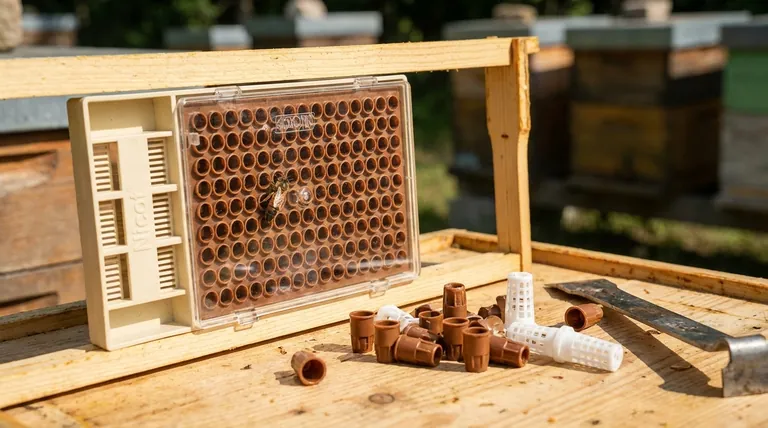In short, Jenter and Nicot systems are specialized kits used in beekeeping for queen rearing. They are designed to completely eliminate the need for "grafting," which is the delicate and difficult process of manually transferring tiny bee larvae from one cell to another. Instead, these systems trick the queen into laying eggs directly into removable plastic cups that can then be used to raise new queens.
The core purpose of a Jenter or Nicot system is to simplify and democratize queen rearing. By bypassing the need for steady hands and sharp eyesight, they make it possible for more beekeepers to successfully raise their own high-quality queens without damaging the delicate larvae.

How Graft-Free Rearing Works
To understand the value of these systems, you first have to understand the problem they solve. Traditional queen rearing requires a beekeeper to find a larva of the perfect age (less than 24 hours old) and carefully lift it out of its wax cell with a special tool, placing it into an artificial queen cup. This process, called grafting, is highly technical and is often where beginners fail.
The Core Component: The Laying Box
At the heart of both the Jenter and Nicot systems is a plastic box that mimics a small section of honeycomb. This box is designed to fit into a standard brood frame.
The front of the box is filled with a grid of small, removable plastic cell cups. In a typical setup, this grid holds around 110 cups.
Confining the Queen
The beekeeper places the laying box (fitted into a frame) into a strong, healthy hive. The queen is then confined to the face of this box using a queen excluder cover.
Because she cannot leave, the queen has no choice but to lay her eggs in the only cells available: the removable plastic cups.
Transferring the Eggs with Ease
Once the queen has filled the cups with eggs, she is released back into the colony. The beekeeper can now wait for the eggs to hatch into perfectly-aged larvae.
Instead of grafting, the beekeeper simply pulls the individual plastic cups—each containing a single egg or young larva—from the back of the laying box. These cups are then attached to a cell bar and placed in a queenless "cell builder" colony to be raised into queen cells.
Understanding the Trade-offs
While these systems offer a major advantage, they are not without their own challenges and considerations. They solve one problem but introduce others.
Advantage: No Grafting Skill Required
This is the primary benefit. It removes the most technically demanding and error-prone step of queen rearing, making the process accessible to beekeepers of all skill levels and physical abilities.
Advantage: Minimal Larval Disturbance
Because the larvae are never touched or removed from their cell, the risk of injury or drying out is virtually zero. This can lead to healthier, more robust queen cells.
Pitfall: Queen Acceptance
The single biggest challenge with these systems is convincing the queen to lay in the plastic box. Some queens are reluctant to lay on plastic and may refuse, delaying the entire operation. This requires patience and sometimes multiple attempts.
Pitfall: Cost and Management
A complete Jenter or Nicot kit is a financial investment compared to a simple 5-dollar grafting tool. The systems also come with many small plastic parts that must be kept clean and organized.
Making the Right Choice for Your Goal
Deciding whether to use a graft-free system depends entirely on your specific beekeeping objectives and skills.
- If your primary focus is raising a few queens without the steep learning curve: A Jenter or Nicot system is an excellent choice that significantly increases your chances of success.
- If your primary focus is large-scale commercial queen production: Mastering traditional grafting is often more time-efficient and cost-effective, as it doesn't depend on queen acceptance of a plastic kit.
- If you struggle with eyesight or have unsteady hands: These systems are a game-changer, enabling you to produce queens when grafting would be physically impossible.
Ultimately, these systems offer a powerful and reliable method for producing new queens, turning a once-specialized skill into a manageable task for any dedicated beekeeper.
Summary Table:
| Feature | Jenter / Nicot System | Traditional Grafting |
|---|---|---|
| Primary Method | Queen lays eggs directly into cups | Manual transfer of larvae (grafting) |
| Skill Level Required | Beginner to Advanced | Advanced, requires practice |
| Key Advantage | Eliminates delicate grafting step | Potentially faster for large-scale production |
| Main Challenge | Queen acceptance of the plastic system | High skill requirement, larval damage risk |
Ready to simplify your queen rearing process?
As a trusted supplier for commercial apiaries and distributors, HONESTBEE provides the reliable beekeeping equipment you need to succeed. Whether you're looking to start with a Jenter/Nicot system or scale up your operations, our wholesale-focused solutions are designed for your productivity.
Contact HONESTBEE today to discuss your equipment needs and discover how we can support your beekeeping success.
Visual Guide

Related Products
- Nicot Queen Rearing Kit for Beekeeping and Grafting in Nicot System
- No Grafting Queen Rearing Kit: System for Royal Jelly Production and Queen Rearing
- Brown Nicot Queen Cell Cups for Breeding Queen Bees Beekeeping
- Plastic Chinese Queen Grafting Tool for Bee Queen Rearing
- JZBZ Push-In Queen Cell Cups for Beekeeping
People Also Ask
- What is essential for successful queen rearing in beekeeping? Master Genetics & Boost Your Apiary's Health
- Can anyone use Queen Rearing with JZBZ? A Beginner-Friendly System for All Beekeepers
- What should be done once eggs are present in the comb box? A Guide to Maximizing Queen Rearing Success
- What are the methods of queen rearing? Master Grafting, Direct Lay & More
- What happens if a larva is grafted too late? Avoid Scrub Queens and Failed Rearing



















